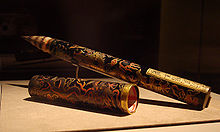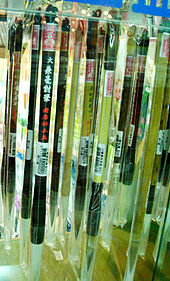- Ink brush
-
 A highly decorative badger hair brush dating back to the Ming Dynasty, featuring dragons inlaid with gold and silver foil.
A highly decorative badger hair brush dating back to the Ming Dynasty, featuring dragons inlaid with gold and silver foil.
Ink brushes (simplified Chinese: 毛笔; traditional Chinese: 毛筆; pinyin: máo bǐ) are used in Chinese calligraphy. They are also used in Chinese painting and descendant brush painting styles. The ink brush was invented in China, believed to be around 300BCE.[1][2] Together with the inkstone, inkstick and Xuan paper, these four writing implements form the Four Treasures of the Study.
Contents
Types
 Ink brushes of various size and material for sale at a Taipei store.
Ink brushes of various size and material for sale at a Taipei store.
Brushes differ greatly in terms of size, texture, material and cost.
- Stalk: Usually normal bamboo, exotic brushes instead may use materials like gold, silver, jade, ivory, red sandalwood or spotted bamboo.
- Hairs source: Normally the brush is made from goat, Siberian Weasel (黄鼠狼 huángshǔláng, Yellow-rat-wolf), pig, mouse, buffalo, wolf and rabbit hair, while exotic ones can be made from tiger, fowl, deer and even human hair (from the first haircut a baby gets, said to bring good fortune while taking the Imperial examinations).
- Hairs texture: soft (軟毫 ruǎnháo), mixed (兼毫 jiānháo) or hard (硬毫 yìngháo) hairs. Certain textures are better for writing certain styles than others are.
- Hairs size: Generally classified as either big (大楷 dàkǎi), medium (中楷 zhōngkǎi) or small (小楷 xiǎokǎi); most calligraphy is written with a medium-sized brush. The smallest brushes are used for very small pieces and for fashioning designs for seals. Medium brushes are the most widely used; wielded by a skilled artist, a medium brush can produce a variety of thicknesses of line, from very thin to fairly thick. The largest brushes are used only for very large pieces.
The hairs one chooses to use depends on one's needs at the moment, certain kinds of brushes are more suited to certain script styles and individuals than others are. Synthetic hair is not used. Prices vary greatly depending on the quality of the brush, cheap brushes cost less than a US dollar while expensive can cost more than a thousand. Currently, the finest brushes are made in the town of Shanlian, in the district of Huzhou, Zhejiang province.
History
The earliest intact ink brush was found in 1954, in the tomb of a Chu citizen during the Warring States Period (475-221 BCE), located in an archaeological dig site Zuo Gong Shan 15 near Changsha (長沙). This primitive version of an ink brush had a wooden stalk, and a bamboo tube secures the bundle of hair to the stalk. Legend wrongly credits the invention of the ink brush to the later Qin general Meng Tian.
Today, Japanese companies such as Pentel and Sakura Color Products Corporation manufacture pens with brushes resembling those of a small ink brush as tips. These brush pens work almost identically to small ink brushes, and can be used for most of the same purposes.
See also
- East Asian calligraphy
- Huzhou ink brush
- Xuan writing brush
References
- ^ Ong, Siew Chey (2005). China condensed: 5000 years of history & culture. Singapore: Marshall Cavendish. pp. 161. ISBN 978-981-261-067-6. http://books.google.com/books?id=bt7q8hfiZ4gC.
- ^ Women of China , Issues 1-6. Foreign Language Press. 1995. pp. 1. http://books.google.com/books?id=nJWyAAAAIAAJ.
Categories:- Calligraphy
- Painting materials
- Writing instruments
- East Asia stubs
Wikimedia Foundation. 2010.
